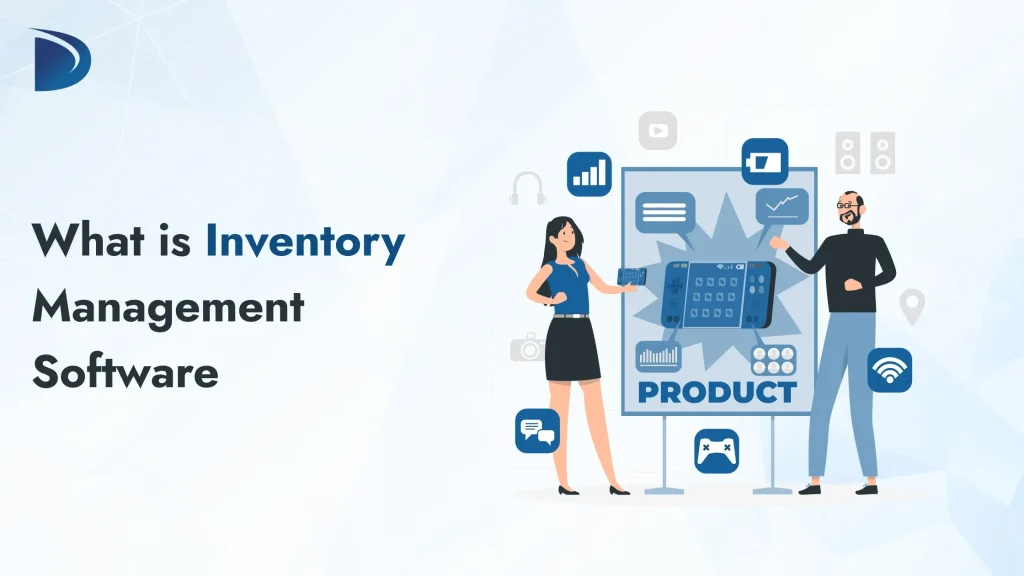Table of Contents
Inventory is one of those things that quietly makes or breaks a business. Having too much of it means you are wasting money and space. Have too little, and you’ll miss sales and frustrate customers. That’s why smart businesses are leaning on inventory management software.
It brings Precision to the chaos, keeps tabs on what’s coming in, what’s going out, and what needs your attention right now. In this blog, we break down everything you need to know about inventory management software, what it does, why it is important, and how it helps you work more effectively every day.
What Is Inventory Management Software?
Inventory management software is a tool that helps organizations track all the products they purchase, store, and sell. Instead of using spreadsheets or writing things down by hand, this software lets you manage everything in one place, quickly and accurately. It shows you how much stock you have, where it’s stored, and when you need to order more. It can also assist with scanning barcodes, creating reports, and sending alerts when items are running low.
For businesses that deal with physical products, such as retail shops, warehouses, or online stores, this type of software makes daily tasks significantly easier. It helps prevent problems like running out of stock or having too many stocks that sit on shelves.
Features of Inventory Management Software
Real-Time Inventory Tracking
Track your inventory as it moves. This feature updates stock levels instantly with every sale, return, or restock, providing you with accurate visibility into what’s available, what’s running low, and what’s selling quickly.
Low-Stock Alerts and Reorder Points
Never run out of key products again. Set custom thresholds for each item and receive automatic alerts when stock levels drop too low. This helps you reorder on time, reduce lost sales, and maintain a smooth supply chain.
Barcode Scanning and Automation
Make inventory updates quick and accurate with barcode scanning. Automate data entry for arrivals and dispatches, saving time and decreasing manual mistakes. It’s a fast and reliable way to keep your inventory precise and organized.
Reporting and Analytics
Turn your inventory data into smart business insights. View in-depth reports on stock movement, trends in sales, product performance, and more. These evaluations help you make informed decisions, optimize inventory levels, and enhance profitability.
Integration with POS Systems
Connect your inventory system with your point-of-sale platform. Every sale, return, and refund automatically updates stock levels in real-time, providing you with full visibility across your sales channels without the need for manual data synchronization.
User-Friendly Interface
There is no need to be skilled in technology. A simple, seamless interface makes it easy for anyone on your team to use the software, monitor inventory status, and complete the responsibilities without hours of training.
Customization Options
Tailor the software to fit your business needs. From setting unique reorder points to customizing reports and workflows, flexibility ensures the system aligns perfectly with your processes, inventory size, and specific goals.
Cloud-Based Access
Manage your inventory from anywhere with internet access. Cloud-based software keeps your data safe, synced, and accessible in real time, even if you are in the office, at the warehouse, or working remotely from your phone or laptop.
Types of Inventory Management Software
Barcode Scanning System
This type utilizes barcode labels and scanners to track products. When you scan an item, the system updates the stock count instantly. It’s fast, lessens mistakes, and works great for smaller businesses.
Warehouse Management Systems (WMS)
WMS helps manage everything inside a warehouse, where products are kept, how they’re picked, packed, and shipped. It keeps your warehouse organized and running smoothly, especially if you have a large number of products and a significant amount of space to manage.
Order Management Systems
This helps keep tabs on customer orders from start to finish. It connects with your sales and inventory, so you always know what has been ordered, what is in stock, and what has been shipped, keeping your orders on track and your customers happy.
Multichannel System
If you sell in multiple locations, such as a website, store, or online marketplaces, this structure keeps all your stock linked. So, when something sells in one place, it updates everywhere, helping you avoid selling more than you have in stock.
RFID Systems
RFID systems utilize unique tags and sensors to track inventory without requiring the manual scanning of each item. It’s quick and doesn’t require direct contact, making it ideal for large warehouses or businesses that manage a substantial amount of inventory.
Benefits of inventory management software
Improved Accuracy
The software keeps track of inventory in real-time, so you always know exactly what you have at any given moment. This reduces the likelihood of counting mistakes, missing items, or incorrect orders, ensuring your records remain clean and reliable.
Better Stock Control
You can easily see which products are flying off the shelves and which ones are sitting too long. This helps you avoid running out of popular items or wasting money on things you don’t need to restock yet.
Reduced Costs
By managing inventory more efficiently, you spend less on storage, avoid overbuying, and reduce losses from expired or unsold products. It also saves time, so your team can focus on more important tasks.
Enhanced Customer Satisfaction
When products are in stock and orders are shipped on time, customers are happy. The software helps ensure you deliver the right items quickly, leading to better reviews and repeat business.
Streamlined Operations
With everything organized in one place, your day-to-day tasks, like tracking inventory, reordering items, or managing sales, become faster and simpler. This helps your business run more smoothly and grow with fewer headaches.
Conclusion
No one has time for inventory headaches. Products go missing, orders get held up, and before you know it, you’re overloaded with problems that, frankly, shouldn’t have even existed. That’s where inventory management software comes in; it simplifies the chaos, keeps things moving, and helps you stay on top of what matters.
At Differenz System, we don’t do anything general. We create smart, flexible solutions built around your workflow. You get clean systems, fewer mistakes, and more time to focus on growing your business.
FAQs
Can inventory management software handle returns?
Yes. Most systems let you manage returned products, update stock levels automatically, and track the reasons for returns. This helps you improve customer service and identify any product-related issues.
What types of reports can I generate?
You can generate reports on inventory levels, sales trends, order history, product performance, stock aging, and other key metrics. These reports help you make data-driven decisions and plan more effectively.
Does it support batch or serial number tracking?
Many inventory systems support batch numbers and serial numbers, which is especially useful for electronics, food items, or regulated industries.
How does it help with demand forecasting?
Inventory software tracks sales trends and historical data, helping you predict future demand. This means you can plan orders more effectively, reduce overstock, and ensure that best-selling products are always in stock.
Is there a limit to how many products I can manage?
It depends on the software. Some entry-level plans have limits, while others offer unlimited products. Always review the plan details to ensure it fits your inventory size.

